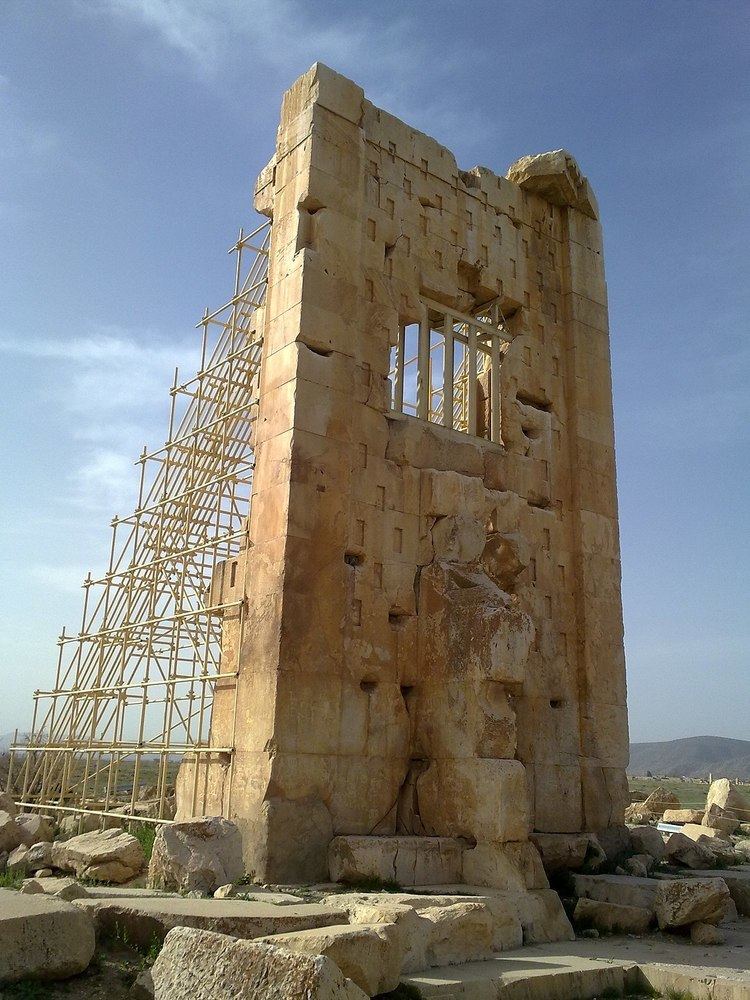Reign 580–559 BC Issue Cyrus II Dynasty Achaemenid Parents Cyrus I | Successor Cyrus II Name Cambyses I Children Cyrus the Great Burial 559Pasargadae | |
 | ||
Grandchildren Cambyses II, Atossa, Bardiya, Artystone, Roxane Similar People | ||
Cambyses I or Cambyses the Elder (via Latin from Greek Καμβύσης, from Old Persian Kambūǰiya-; Elamite: Kanbuziya, Akkadian: Kambuziya, Aramaic Knbwzy; c. 600 BC – 559 BC) was king of Anshan from c. 580 to 559 BC and the father of Cyrus the Great (Cyrus II), younger son of Cyrus I, and brother of Arukku. He should not be confused with his better-known grandson Cambyses II.

Cambyses was an early member of the Achaemenid dynasty. He was apparently a great-grandson of its founder Achaemenes, grandson of Teispes and son of Cyrus I. His paternal uncle was Ariaramnes and his first cousin was Arsames.

According to Herodotus, Cambyses was "a man of good family and quiet habits". He reigned under the overlordship of Astyages, King of Media. He was reportedly married to Princess Mandane of Media, a daughter to Astyages and Princess Aryenis of Lydia. His wife was reportedly a granddaughter to both Cyaxares of Media and Alyattes II of Lydia. The result of their marriage was the birth of his successor Cyrus the Great. According to Nicolas of Damascus his original name was Atradates, and he was wounded and later died in the Battle of the Persian Border which he, with his son, fought against Astyages. It occurred in about 551 BC, and he is reported to have received an honorable burial. According to Herodotus, Astyages chose Cambyses as a son-in-law because he considered him to pose no threat to the Median throne, having dreamt his daughter would give birth to one who would rule Asia. This was not the case with Cyrus the Great who would go on to depose his grandfather, and begin the Persian Empire.
Etymology
Though numerous scholars link Cambyses to the Sanskrit tribal name Kamboja there are also few scholars who suggest Elamite origin of the name. Jean Przyluski had sought to find an Austric (Kol or Munda) affinity for Kamboja.
Friedrich von Spiegel, Sten Konow, Ernst Herzfeld, James Hope Moulton, Wojciech Skalmowski and some other scholars think that Cambyses (Kambujiya) is adjectival form of the Sanskrit tribal name Kamboja.
Spiegel also regards Kamboja/Kambujiya (Cambyses) and Kuru/Kyros (Cyrus) as the names of two pre-historic/legendary heroes of the Indo-Iranians (i.e. prior to their split into Indo-Aryans and Iranians ) which were later revived naturally in the royal family of the Achaemenes and further opines that the myths about Cyrus were largely due to the confusion between the historical and the legendary heroes of the prehistoric period
James Hope Moulton regards Spiegel's suggestions as the best of other etymological explanations of these two names.
As against this, Arnold J. Toynbee discusses the issue of two Persian names Kambujiya (Cambyses) as well as Kurush (Cyrus) elaborately and regards them both as derived from the two Eurasian nomads, the Kambojas and the Kurus mentioned in the Sanskrit texts and who, according to him, had entered India and Iran in the Volkerwanderung of 8th and 7th century BCE.
Toynbee concludes that the conquest of the world by elder branch of the House of Achaemenes had been achieved by the valor of the Kuru and Kamboja Nomad reinforcements, hence as a commemoration, the elder branch of the House had named all their great princes from Cyrus I onwards, alternately, as Cyrus (Kurosh/Kuru) and Cambyses (Kambujiya/Kamboja).
